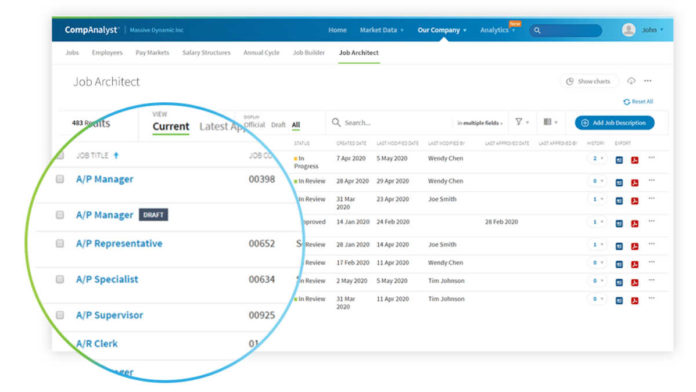
Salary.com launched a tool to help employers organize and manage their job descriptions. Called Job Architect, the tool can be used as a standalone product or as an integrated component of the company’s CompAnalyst platform.
Job Architect takes aim at “hiring velocity,” more commonly referred to as time to hire. Because job descriptions are usually created piecemeal—by different managers in different departments throughout an organization—employers often struggle to appropriately budget for roles, Salary.com believes.
Salary.com launched Job Architect, a central management tool for job descriptions that streamlines comp workflow. #HR #HRTech @Salary Share on XIn addition, it said, poor job descriptions hamper retention because compensation and skill sets fall out of alignment with the organization’s needs, employee expectations and, we’d add, the market.
“We’re seeing unprecedented upheaval in how companies are defining jobs and managing the work that people do,” said Salary.com CEO Kent Plunkett. “Job Architect helps companies manage their job content library to get job descriptions right and optimize the performance of their people.”
Organization-Wide Job Architecture
At core, Job Architect helps HR standardize a company’s job architecture, the framework it uses to align workers with specific roles based on job requirements, responsibilities and skills. It allows for the central management of job descriptions and automates the process of market-pricing jobs, Salary.com said. That, in turn, makes workflows and approvals more efficient and encourages collaboration between executives, hiring managers, talent acquisition specialists and HR.
Helping organizations manage compensation more efficiently is one of Salary.com’s underlying missions. “Our customer is typically completely overwhelmed,” Plunkett told us during a conversation in April. “So they’re coming to us and looking for how can they be more efficient and effective in getting pay right, so that they can move on to do other things, as well.”
CompAnalyst data uses machine learning and regression analysis to generate predictive data and, as Plunkett put it, “answer the question of what is fair pay.”
Sign up for our newsletter here.
Image: iStock













